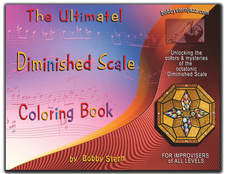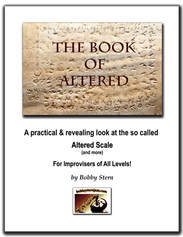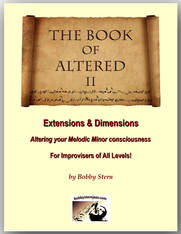Diminished Perspective vs. Altered Reality
The Fight For Dominants

Referring to none other than the Diminished vs. Altered Scale, I've been privy to recent discussions as to which one is the more suitable choice to express an altered dominant chord.
Therefore, I thought we might get these two dominant scalar heavyweights to slug it out in the ring for 13, or maybe even b13 rounds. This is a telling number, but we’ll get to that momentarily.
In the near corner, wearing the purple trunks, hailing from Symetria, Octatonia – the octatonic Diminished Scale, aka Auxiliary Diminished, Diminished Dominant, Half Step/ Whole Step. He’s been called other things, as well.
This guy is known to have a pronounced split personality, which actually works to his advantage once he swings into full action. If his initial move is a whole step, he falls into predominantly diminished 7th chord patterns.
He’s akin to a right handed fighter, who normally leads with his left, who can change up at a moments notice and lead with his right, lefty style - a switch hitter of sorts.
He also has the supernatural power to divide himself into two and / or four “mini me’s” simultaneously, making him very formidable in any context.
It’s this unusual style that has, for many years now, confused both friend and foe alike. “What’s wit all da toiminolgy”, is the common cry among the ranks. Half step/ whole step, Whole step/ half step, Inverted, Auxiliary, schmilary…watch that hole...step! Aaarrgh!
I’d like to do my civic duty and add to the confusion.
Anybody who is familiar with Afro-Cuban music and its derivations, will be familiar with the concept of “clave”, the two measure rhythmic “key” - the foundation that everything else is built upon.
It has two perceived sides – either 3-2 (ta – ta – ta/ - ta – ta) or 2-3 clave ( - ta – ta/ ta – ta – ta), depending on where the “one” is perceived to be at.
Not to deviate, but the point here is, that if the two sides of clave can be identified by inverting a number which describes its accents per measure, why can’t we do the same thing, name wise (describing it’s interval order), for the diminished scale?
Because - we can!
How about the 2-1 Diminished (whole step side), or 1-2 Diminished Scale (half step side), in reference to the number of semitones at the start?
Makes sense to me.
We just have to keep in mind that when expressed vertically, as a chord in thirds, the
2-1 Diminished = dim.7 (Maj7) 9 11 b13, "diminished side", and the
1-2 Diminished = 7 b9 #9 #11 13, "dominant side".
In mind it’s kept.
It is with his 1-2 (dominant) side that he will be entering the ring. After all this is the “Fight for Dominants”, right?
Now, over here in the far corner, in the gold trunks, the pride of Melodicus Minorus, the scion of its Seventh House, is none other the "Altered Scale", who's true title is "Seventh Mode of Melodic Minor".
Altered indeed. This dude is a direct descendant, although a mutant one, of the Major Scale Matrix, which is in itself a manifestation of the cosmic overtone series, known to one and all as the “Circle of Fifths”.
As legend has it, at birth, one of his genes - the Maj 3rd - was mutated down a half step, so that it became a min 3rd instead, which in turn interrupted the Cycle of Fifths, transforming him into a multiple Tritonian.
This mutation has given him the special powers that he is able to manifest, chief among them being the ability not only to exhibit half / whole step diminished scale characteristics, like his ring partner, but also pure whole tone / augmented tendencies, as well. Hence, the moniker “Diminished / Whole Tone Scale”, often mentioned when referring to his Seventh Mode.
He also answers to Ascending Melodic Minor, Jazz Minor and Ionian b3.
But, since its his Seventh Mode from which his fame is most assuredly derived, as it contains the root, 3rd & 7th of a dominant 7th chord, plus all four of the possible altered dominant extensions - b9, #9, #11 (b5) & b13 – he became known far and wide as the “Altered Scale”.
There are, however, still too many members of the community who don’t realize or recognize that all these names, labels and aliases refer to one and the same entity. And that they all led back to the one – Melodic Minor!
So now that we’ve got the preliminaries for each out of the way, it’s time to weigh in with a physical comparison.
The above graphic illustrates how these two altered dominant favorites, dressed up in their own altered versions of G7, stack up against each other.
First of all, the first five notes, plus the last one, of each scale are exactly the same. The only difference occurs on the sixth degree (and seventh of the diminished). As the arrows in the above graphic point out, the Altered Scale actually "splits the difference" between the Diminished Scale's sixth and seventh scale step, D (5) and E (13); settling on an Eb (b13) as its sixth step.
That, in a nutshell, is the difference between these two scales. That the 1-2 Diminished Scale has a natural 13, while the Altered Scale sports a b13, pretty much sums the difference.
But what does it all mean, Mr. Natural?
Well, for starts, the Eb creates a five-note consecutive whole tone row - from Cb through G - just one note short of a full Whole Tone Scale.
It also cancels the Diminished Scale's total half step / whole step symmetry, although from F through Db, it's still in full effect.
This process, which is really only used here as an example to point out the differences between the two scales, can be reversed as well.
D-I-N-G!
Am I the only one who heard a bell?
B. Stern




 RSS Feed
RSS Feed








